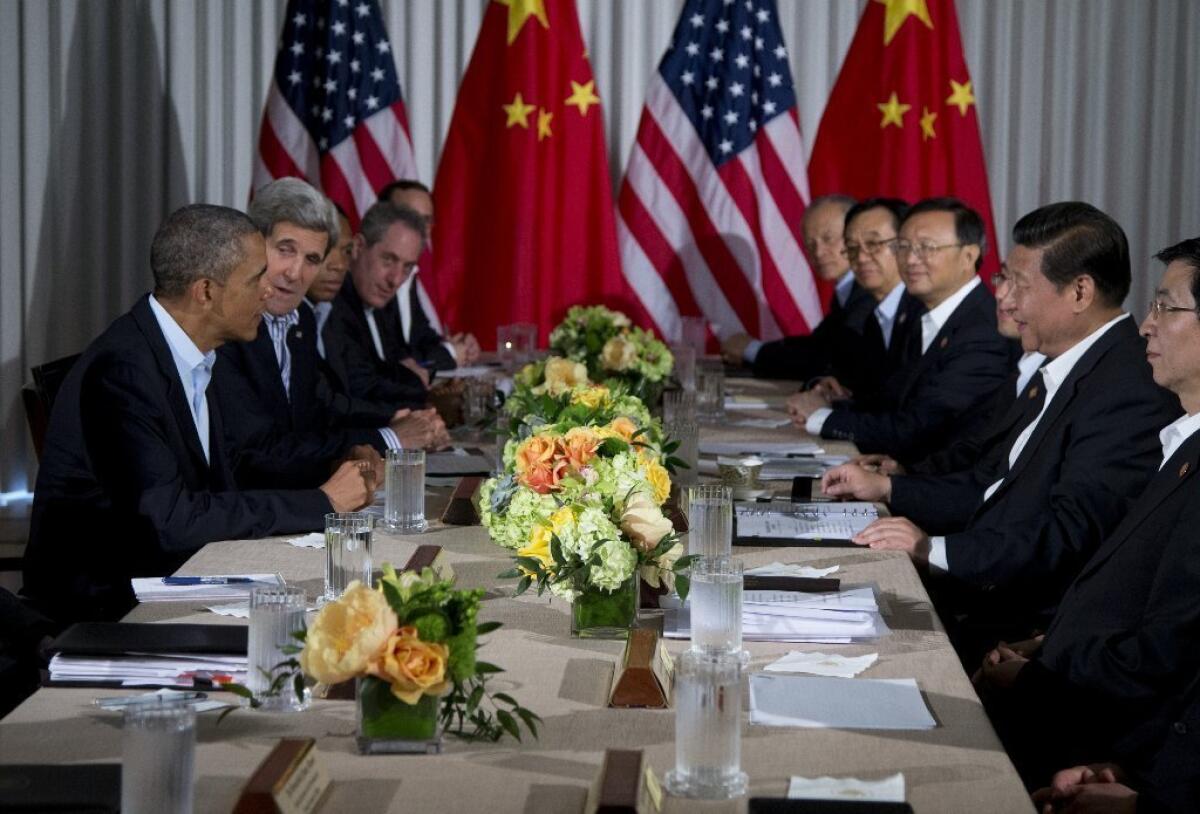The awkward state of U.S.-China relations

- Share via
As 2013 draws to a close, where does the complex and consequential relationship between the United States and China stand? Relations between the two nations are enormously broad now, with hundreds of policy issues from agriculture to zoology joining American and Chinese interests. Even when we look to some of the key issues, no convincing pattern emerges.
On the security front, 2013 was decidedly mixed. Washington and Beijing worked side by side when it came to the negotiations over Iran’s nuclear program, and China supported the breakthrough six-month interim deal with Tehran. On North Korea, there was less daylight between the U.S. and China than in years past, and in September, China announced a prohibition on exporting to its neighbor a long list of equipment and chemicals that could be used in weapons.
Workaday Sino-American cooperation on piracy and counternarcotics continued apace, and for the first time, China agreed to join next year’s U.S.-hosted RIMPAC, the largest annual international marine exercise, signaling a new willingness to engage with other militaries on terms it does not fully control.
YEAR IN REVIEW: 10 groundbreaking women we lost in 2013
But China’s unexpected declaration in November of an air defense identification zone did not go over well in Washington. To be sure, such zones are not inherently destabilizing. But the fact that China’s overlaps with Japan’s and includes the disputed Senkaku/Diaoyu islands, and that China did not consult with its neighbors or the United States before its announcement, meant that the new policy exacerbated tensions in the East China Sea. “No surprises” is a central tenet of the “new model” for major power relations the Obama and Xi administrations pledged to build at the Sunnylands summit this summer, and China did not score well on this early test.
The economic realm delivered more cause for optimism. China’s third party plenum in November resulted in an impressive array of promises for significant domestic policy changes, best encapsulated by the sentence in the official communique that the market should play a decisive role in the allocation of resources in the economy. If fully implemented, these reforms would mean that state-owned enterprises will be less privileged and Chinese consumers more empowered, both positive developments for U.S. businesses.
Further, national security advisor Susan Rice’s recent speech on Asia policy explicitly opened the door for China to join the Trans-Pacific Partnership, or TPP, at a future date when China can meet the high standards currently being devised by the 12 negotiating countries. Chinese analysts seem more willing now to believe that the TPP is not an underhanded U.S. attempt at containment but a genuine effort to loosen economic flows between nations while also protecting labor, the environment and intellectual property. Bilateral investment treaty negotiations between the U.S. and China also continue.
YEAR IN REVIEW: Highs and lows from Obama’s roller-coaster year
On climate and energy, the important agreement this year between the United States and China to phase out production of hydrofluorocarbons — particularly potent greenhouse gases — was a great first step. But implementing this promise will take a great deal more work. Cooperation on clean energy is minimal but increasing.
The realm of values was fraught in 2013. Not only was there no notable progress on individual rights in China, but Beijing also continued its crackdown on lawyers, professors, activists and writers trying to hold China accountable to its own laws and international human rights standards. Foreign media have been increasingly targeted, with scores of New York Times and Bloomberg reporters unsure whether their visas will be renewed.
The infamous “Document 9,” issued in August from the highest level of the Communist Party, cautioned all cadres to beware of the “seven perils” of Western ideals, such as constitutional democracy, media independence and universal human rights. The party laments the lack of trust in the U.S.-China relationship while simultaneously instructing its members to guard against the influence of Americans’ most deeply held values.
YEAR IN REVIEW: The good, the bad and the hopeful in wilderness news
For better or worse, this complex brew of tension, hope, progress and retrenchment is what we can expect from the modern-day U.S.-China relationship. The two huge powers have divergent interests but also deep interdependence. Working together is hard and frustrating, but not working together is worse. Both countries have managed to compartmentalize disagreements so cooperation in some areas can generate real progress. Given the differences, even these modest successes are worth celebrating.
Nina Hachigian is a senior fellow at the Center for American Progress and the editor of “Debating China: The U.S.-China Relationship in Ten Conversations.”
More to Read
A cure for the common opinion
Get thought-provoking perspectives with our weekly newsletter.
You may occasionally receive promotional content from the Los Angeles Times.






